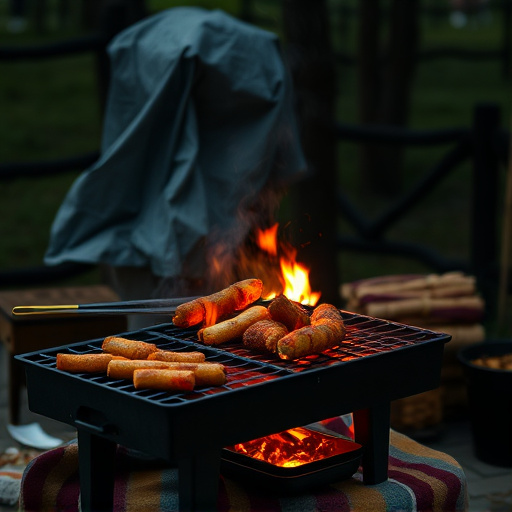Choosing the perfect BBQ brisket for an oven-baked recipe starts with a high-quality, well-marbled cut (4-7 pounds) with a thick, even fat cap. Seasoning is key—a blend of salt, pepper, garlic powder, and paprika, enhanced with brown sugar or mustard powder for extra tenderness and flavor. Preheat your oven to 275°F (135°C), place the brisket on a rack in a roasting pan, and maintain consistent temperature using an oven thermometer. You can opt for a dry rub or wet rub, each offering unique advantages for your home-cooked BBQ brisket masterpiece.
Unleash the ultimate BBQ experience with a mouthwatering oven-baked brisket that’s sure to impress! This comprehensive guide takes you on a journey from choosing the perfect cut to mastering the art of seasoning and cooking techniques. Learn the secrets behind achieving a rich, smoky flavor and discover the best rubs, sauces, and sides to elevate your brisket game. Whether you’re a seasoned cook or a BBQ enthusiast, this recipe ensures a tender, flavorful masterpiece. Get ready to transform your kitchen into a carnivore’s paradise!
- Choosing the Right Brisket
- – Selecting a good quality brisket for maximum flavor potential.
- Seasoning 101
- – Techniques and tips for seasoning the meat to create a rich, smoky flavor.
- Oven Setup and Temperature Control
- – How to prepare your oven for slow-roasting and maintaining consistent temperature.
- Baking Method: Dry Rub vs. Wet Rub
- – Comparisons between two popular rub methods and their effects on brisket's final taste.
Choosing the Right Brisket
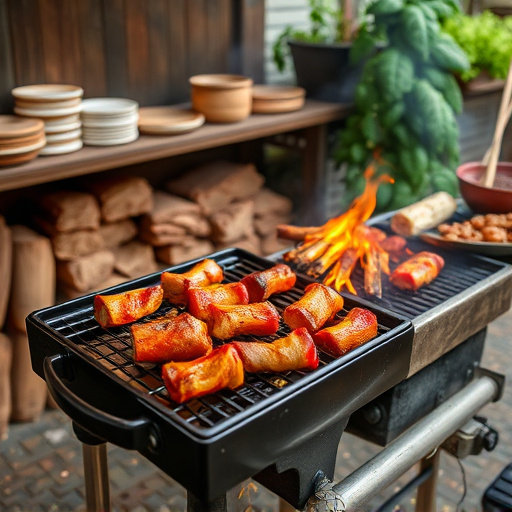
Choosing the right brisket is half the battle when it comes to crafting a mouthwatering BBQ brisket recipe in the oven. Opt for a good quality, well-marbled cut, aiming for a weight between 4-7 pounds. The fat cap on your brisket acts as natural flavor and moisture retention, so don’t be afraid of a thicker layer. Look for a consistent marbling throughout, which ensures even cooking and maximum flavor development.
A good rule of thumb is to select a brisket with a pinkish-red color and firm texture. Avoid any signs of bruising or large patches of white fat. The point (the leaner end) should have some fat cap, while the flat (the fattier end) can be slightly more marbled. This balance ensures that your oven-baked BBQ brisket remains tender and succulent during the long, slow cooking process.
– Selecting a good quality brisket for maximum flavor potential.

When it comes to crafting a mouthwatering BBQ brisket recipe, starting with the right cut is paramount. Opt for a high-quality, well-marbled brisket to ensure maximum flavor potential. Look for a piece with even fat distribution; this adds richness and moisture during the slow-cooking process. A good rule of thumb is to choose a brisket with at least 1/4 inch of fat cap, which will render down and impart an irresistible crunch during baking in the oven.
Prioritizing freshness is key; select a whole packer brisket from a reputable source, ensuring it’s as close to the butcher’s block as possible. This guarantees you’re getting prime meat with optimal taste and texture. Properly stored, fresh brisket will have a deep, savory aroma and firm yet supple flesh—signs of exceptional quality that will translate into an unforgettable BBQ brisket recipe when cooked in your oven.
Seasoning 101

Seasoning plays a crucial role in transforming a simple piece of brisket into a mouthwatering BBQ masterpiece. When it comes to oven-baked brisket, the right combination of spices can elevate its flavor profile dramatically. Start by rubing a generous amount of salt and pepper onto the meat to create a robust base. Then, experiment with other seasonings like garlic powder, onion powder, paprika, cayenne pepper, and dried herbs such as thyme or rosemary for added depth. These ingredients not only enhance the taste but also help to break down the brisket’s connective tissues, making it tenderer when cooked slowly in the oven.
For an extra kick, consider adding a dry rub blend specifically designed for BBQ brisket recipes. This mixture can include brown sugar for caramelization and a touch of mustard powder to create a sticky glaze. Remember, seasoning is an art, so feel free to adjust quantities based on your preference. Whether you’re a fan of mild or spicy flavors, the key is to let the quality ingredients shine while cooking this tender, flavorful oven-baked brisket.
– Techniques and tips for seasoning the meat to create a rich, smoky flavor.

Creating a rich, smoky flavor for your oven-baked BBQ brisket starts with the right seasoning blend. A classic combination includes salt, pepper, garlic powder, and paprika, which bring out the meat’s natural juices and give it a robust taste. For an extra depth of flavor, consider adding a touch of brown sugar or mustard powder; these ingredients contribute to the meat’s tender texture and enhance its sweetness without overpowering the smoky profile.
Tip for optimal results: Pat the brisket dry before seasoning to ensure better adhesion. Apply the rub generously on all sides, massaging it into the meat slightly. For an extra kick, you can also inject your brisket with a brine or marinade 24 hours before baking; this technique helps tenderize the meat and intensifies its overall flavor.
Oven Setup and Temperature Control
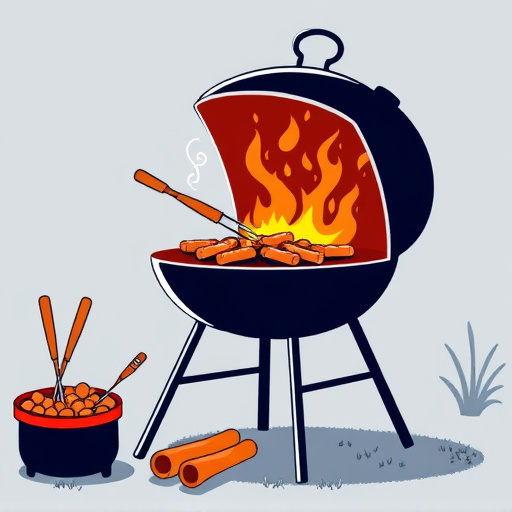
Baking a perfect BBQ brisket in the oven requires precise temperature control and the right setup. Preheat your oven to 275°F (135°C) for the best results—this gentle heat allows the meat to cook slowly, ensuring a tender, flavorful outcome. Place the brisket on a rack inside a roasting pan; this setup promotes even cooking and lets any rendered fat drip away, keeping the meat moist. Use an oven thermometer to monitor temperature accuracy, as ovens can vary significantly, especially when using convection settings or different racks. This attention to detail is key to achieving that mouthwatering, slow-cooked BBQ brisket recipe in your own kitchen.
– How to prepare your oven for slow-roasting and maintaining consistent temperature.
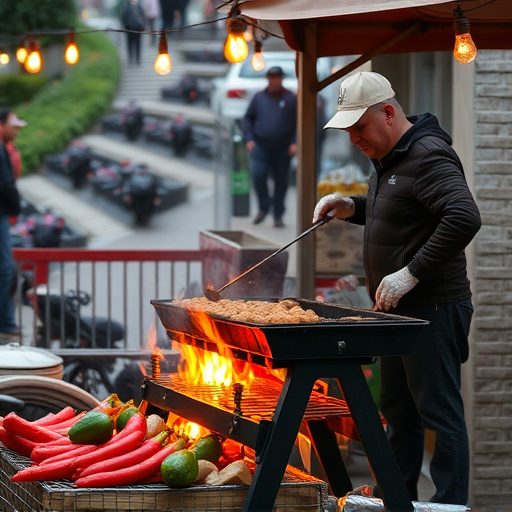
To prepare your oven for slow-roasting a BBQ brisket, start by preheating it to a low temperature—typically around 225°F (107°C). This gradual heating ensures even cooking and helps maintain a consistent temperature, crucial for achieving tender, flavorful results. Place a rack in the middle of the oven and line a large roasting pan with foil for easy cleanup.
For consistent temperature maintenance, consider using an oven thermometer to monitor the accuracy of your oven’s heat. This simple step prevents overcooking or undercooking your brisket. Additionally, keep the door slightly ajar after closing it; this allows steam to escape, preventing moisture buildup that can lead to a wet, tough finish.
Baking Method: Dry Rub vs. Wet Rub
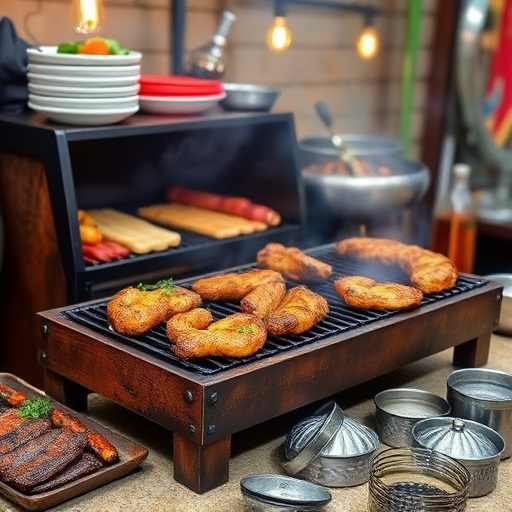
When it comes to baking BBQ brisket in the oven, one key decision is whether to use a dry rub or a wet rub. A BBQ Brisket Recipe Oven dry rub consists of a blend of spices that are directly rubbed onto the meat before cooking. This method allows the flavors to penetrate the flesh, creating a rich, complex taste. The dry rub can be made ahead of time and stored, making it convenient for busy days when you want a delicious, slow-cooked meal without the hassle of constant attention.
On the other hand, a wet rub involves mixing spices with ingredients like vinegar, citrus juices, or even beer to create a paste that is slathered onto the brisket during cooking. This method not only adds flavor but also helps keep the meat moist and tender. Wet rubs are ideal for those who prefer a more intense marination and want to ensure the brisket remains succulent throughout the baking process. Both techniques have their advocates, so choose based on your taste preferences and convenience.
– Comparisons between two popular rub methods and their effects on brisket's final taste.

When it comes to seasoning a BBQ brisket, rubs are an art form in themselves. Two popular methods include dry rubbing and injection. Dry rubbing involves coating the meat with a mixture of spices before cooking; this technique creates a rich, complex flavor as the spices caramelize during the long, slow bake in the oven. The result is a brisket that’s incredibly tender and packed with depth of taste.
On the other hand, injection rubs involve marinating the meat by injecting a spice blend directly into the muscle fibers. This method ensures even distribution of flavor throughout the brisket. While it may not impart the same level of surface caramelization as dry rubbing, injected brisket tends to be incredibly moist and tender, with a burst of savory goodness in every bite. Each technique offers unique advantages, catering to different preferences for BBQ brisket recipes in the oven.
